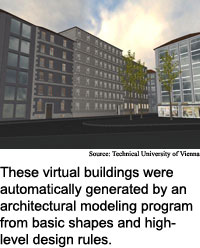
Software speeds modeling
By
Ted Smalley Bowen,
Technology Research NewsIt often takes years to guide a building from conceptual sketch to completion. Along the way are myriad reviews, revisions, and modifications. Scale up to a city block, and the complexity mushrooms.
Researchers at the Georgia Institute of Technology, Vienna University of Technology in Austria and the French National Institute for Research in Computer Science and Control (INRIA) have developed software that uses grammars, or sets of rules, to automate steps in the design modeling process.
The software speeds the graphical modeling of buildings and their environs, allowing designers, planners and residents to more quickly assess their options and to consider more of them, according to Peter Wonka, a researcher at the Georgia Institute of Technology.
The researchers' system uses shape grammars, or rules that combine, divide and refine basic forms like boxes, cylinders, and pyramids into elements like buildings.
The grammars include guidelines for dividing all or part of a given shape, or for transforming it into another shape of the same volume. These split grammar guidelines can be used to evolve a shape, said Wonka. This makes it possible to change a block into a building through many applications of different rules, he said.
The system associates attributes with rules so that structures follow basic architectural norms. Attributes include color variation, horizontal and vertical emphasis of specific floors and columns, and having or not having shops on the ground floor of the building.
The more, and more specific, the rules in the database, the more detailed a model can be, in terms of surface textures, shading, and complex geometry, Wonka said. "The important aspect of our system is that the rules can be applied automatically together with the specification of some high level design goal," said Wonka.
The software is fast because it uses a single rules database -- a hierarchical set of design rules -- to automatically invoke appropriate rules for a given design. In contrast, existing grammar tools call for separate rules for each object designed, according to Wonka.
The system underlying the researchers' prototype can also be used in traffic simulations, data visualization, military simulations, and games.
The researchers' software addresses a different aspect of design than computer aided design (CAD) tools: automated modeling rather than precise structural detail, said Wonka. "We intended our system for a quick sketching of design ideas," he said.
The system makes it possible to quickly model the environment surrounding the main subject of design, said Wonka. "The precise detail of the surrounding buildings is not so important, so an automatic system can save some modeling time."
The tool can also speed computer game and movie creation by quickly filling in scenes with detailed objects, leaving more time for manually designing important buildings or landmarks, Wonka said, noting that many buildings can be modeled in a few seconds.
The research advances the evolution of shape grammars from a manual method of analyzing design styles to a computer-automated design tool, said Terry Knight, Associate Professor of Design and Computation at MIT.
The researcher's method of using and modifying grammar rules to represent design changes is a simpler, more efficient use of shapes than the usual symbolic approach, Knight said. "While there are aspects of the formalisms the [researchers] present that could be simplified, their project points to the huge area of untapped potential for shape grammars," she said.
The researchers are planning to develop an interactive editor for large-scale environments, and to simulate a major American city. They are also working on more precise and complex rules for the system's grammar along with significant and recognizable architectural styles.
They are planning to release the software next year as a plug-in that will work with Alias Systems' Maya three-dimensional design and animation software.
Wonka's research colleagues were Michael Wimmer of the Vienna University of Technology, Franois Sillion of the French National Institute for Research in Computer Science and Control, and William Ribarsky of Georgia Institute of Technology. The researchers presented the work at the Association of Computing Machinery (ACM) Special Interest Group Graphics (Siggraph) 2003 conference in San Diego, July 27 to 31. The research was funded by the Austrian Science Foundation.
Timeline: < 1 year
Funding: Government
TRN Categories: Graphics; Data Representation and Simulation
Story Type: News
Related Elements: Technical paper, "Instant Architecture," Siggraph 2003, San Diego, July 27-31.
Advertisements:
August 27/September 3, 2003
Page One
Software speeds modeling
DNA plays tic-tac-toe
Email updates six degrees theory
Cellophane turns LCDs 3D
News briefs:
Detector senses single DNA
Crystal shortens infrared waves
Tool sketches quantum circuits
Nanotubes spark gas detector
Metal process makes heat chips
Light makes molecule shine

News:
Research News Roundup
Research Watch blog
Features:
View from the High Ground Q&A
How It Works
RSS Feeds:
News
Ad links:
Buy an ad link
| Advertisements:
|
 |
Ad links: Clear History
Buy an ad link
|
TRN
Newswire and Headline Feeds for Web sites
|
© Copyright Technology Research News, LLC 2000-2006. All rights reserved.